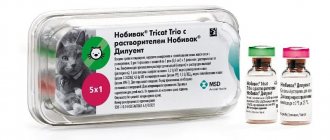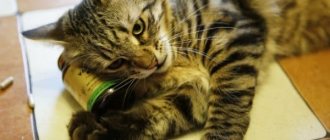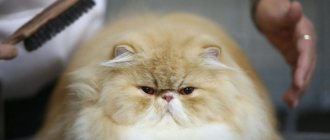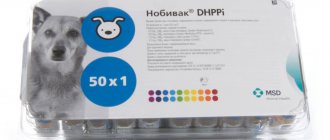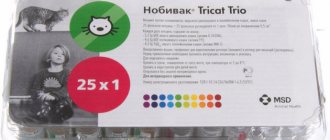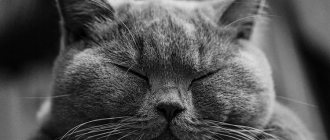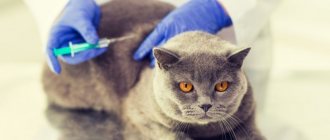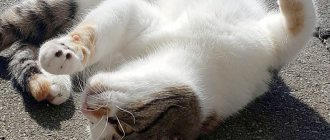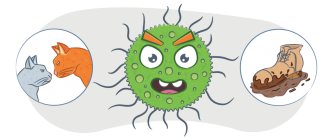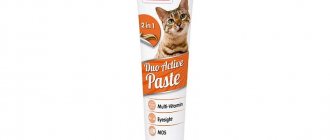One of the important vaccines is Nobivak for cats, which is recommended to be injected into the withers of pets to prevent the development of panleukopenia, calcivirosis, and rhinotracheitis. The drug is of high quality, produced by a Dutch company, and therefore rarely causes adverse reactions or other unpleasant consequences. Vaccination of kittens and adults using the Nobivak vaccine is performed in a veterinary clinic by an experienced specialist.
Components and features of the action
Nobivac Tricat Trio is a comprehensive vaccination that is prescribed for kittens and adult pets. Thanks to its unique composition, it is possible to prevent the progression of many infectious diseases. The medicine for cats contains the following components:
- 5.2 lg plaque forming units (PFU) of feline rhinotracheitis virus;
- 4.6 lg PFU of calicivirus infection;
- 4.3 lg TCD50 of panleukopenia virus.
For better action, Nobivak contains hydrolyzed collagen, as well as pancreatic hydrolyzate casien glucite and potassium hydrogen orthophosphate buffer. The action of the drug is aimed at suppressing the activity of pathogenic microorganisms that provoke the development of panleukopenia, rhinotracheitis and calcivirosis. After using Nobivak by kittens and cats, the body begins to produce specific antibodies after 10 days. Nobivac is effective against some diseases for 3 years; against others, for example, calcivirus, the immune system protects cats for about 12 months.
Nobivac Ducat
The vaccination is intended to prevent and strengthen immunity to viral diseases such as herpes and calicivirus.
Release form
Nobivac Ducat consists of two components: grafting and solvent. They are packaged for one dose, in volumes of 0.5 ml and 1 ml, respectively. Both components are supplied in glass, hermetically sealed bottles with aluminum reinforcement.
Compound
Nobivac includes:
- FEF cell line infected with herpes and calicivirus viruses;
- Sucrose;
- Sodium dihydrogen phosphate;
- Hydrolyzed gelatin;
Storage conditions
The vaccine does not lose its properties for 2 years, the solvent does not lose its properties for 5 years, if the storage rules have not been violated. After opening and mixing, the drug should be used within half an hour. Storage temperature – 2-8°C.
Instructions for use Nobivac Ducat
Vaccination Nobivak Dukat can be carried out one and a half months after the birth of the animal. The procedure is repeated after 3 weeks.
Before use, you need to mix the two components until smooth and warm them in your hands to room temperature. The vaccine is administered using a syringe, intramuscularly or under the skin. The puncture site is treated with alcohol or other antiseptic.
Duration of treatment
Revaccination is carried out once a year.
Adverse reactions
There are no obvious side symptoms. In some cases, the animal's body temperature may rise and swelling may form around the puncture. However, symptoms disappear after 2 days without drug intervention.
An analogue of the Nobivac Ducat and Tricat trio vaccines is Globfel-4 serum, used for calicivirus, rhinotracheitis, plague and chlamydia.
What is it for?
The schedule and dose are selected individually by a specialist.
A vaccination regimen using Nobivak is prescribed by a veterinarian and the drug helps protect cats and small felines from the following dangerous diseases:
- Panleukopenia. In veterinary medicine, this pathology is also known as feline distemper, which is highly contagious. The disease disrupts the functioning of the heart, gastrointestinal tract and respiratory system. If the Nobivak Triket Trio vaccine was not administered on time, then there is a high probability of getting sick.
- Calcivirosis. The deviation is caused by viruses that affect the upper respiratory organs, as well as the oral cavity of cats. In advanced cases, lameness develops.
- Rhinotracheitis or feline herpes. Refers to acute viral respiratory diseases, which affects the visual and respiratory organs.
If a kitten and an adult are not vaccinated in time using the drug “Nobivak”, then in case of infection with panleukopenia, the probability of immediate death is 90%.
Complications after vaccination and side effects
Complications after vaccination in cats do not often occur. In any case, the animal owner must be aware of some of them in order to promptly notice and protect the animal. One of the dangerous complications after vaccination is the development of chronic renal failure.
In the course of research conducted by scientists, a direct connection was established between the development of chronic disease in cats and a complex vaccine against rhinotracheitis, calicivirosis and panleukopenia. This is due to the fact that the viral agents used to create the vaccine are grown in cell cultures.
Cat kidney cells are used to create a complex vaccine. As a result of an autoimmune failure, the body begins to attack not only foreign cells, but also its own.
Another complication after vaccination is an allergic reaction that occurs in response to the introduction of foreign agents into the body. The most serious manifestation of an allergy to a vaccine is anaphylactic shock. The development of the reaction occurs rapidly, affecting the respiratory system of the animal.
Allergic reactions that occur during vaccination include:
- vasculitis;
- hemolytic type anemia;
- thrombocytopenia.
In order to avoid side effects, it is necessary to minimize the risk by adhering to the following rules:
- do not immunize frequently (according to the schedule of vaccinations);
- weigh all factors before immunization each time;
- It is recommended to measure the antibody titer in the bloodstream before each vaccination in order to assess the need for vaccination against a particular disease.
What types are there?
There are a number of Nobivac products with different effects.
You should not choose vaccinations against rabies and other serious pathologies in cats on your own, since there are many varieties, which only an experienced veterinarian can help you understand. There are these types of drugs that have different actions:
- "Nobivak Tricket Trio" for cats;
- Nobivac BB;
- Rabies;
- Forcat;
- solvent "Diluent";
- "Nobivak Dukat".
What diseases does a vaccine help against?
Multifel-4 is designed to protect adult cats and kittens from panleukopenia, rhinotracheitis, calicivirus infection and chlamydia. Each of these diseases poses a serious problem for animals, since it is very difficult to combat pathogens with the help of medicines. The only solution may be to vaccinate the cat. In this case, the animal’s body independently inactivates pathogenic agents. The Multifel-4 vaccine, used for vaccinations, copes well with the task.
global $ads_google; //data-ad-slot=”2475549904″ $ads_google = empty($ads_google) ? false : true; ?> if ($ads_google == false) {?>
Panleukopenia has a second name - “feline distemper”. The causative agent of the disease is a virus from the genus Pavoviridae. The microbe remains stable in the environment for up to one year. Without a vaccine, the disease occurs in the form of acute infectious gastroenteritis. With panleukopenia, general intoxication of the cat’s body begins, accompanied by fever and abdominal pain.
Rhinotracheitis is an acute contagious disease that suddenly begins. The culprit is the feline herpes virus, which affects the respiratory organs of the animal. The disease is characterized by coughing, sneezing, rhinitis, purulent conjunctivitis, salivation, and high fever.
Calicivirus infection begins when the pathogenic microorganism calicivirus enters the cat's body. The oral cavity, sinuses, and eyes are primarily affected. Symptoms of the disease are respiratory phenomena, conjunctivitis, stomatitis. Cats that have recovered from the disease are resistant to re-infection, but are carriers of the infection.
Chlamydia develops when infected with bacteria of the genus Chlamydia, which are intracellular parasites. The first 7-10 days the disease is hidden. When the incubation period ends, the cat will show various symptoms. This may include short-term fever, conjunctivitis, lacrimation, urethral discharge, and weakness.
Instructions for use
It is possible to get the Nobivak Forket vaccination and its other types at a veterinary clinic. Before immunizing pets, it is necessary to mix the vaccine powder with Nobivak Diluent or saline solution in an amount of 1 ml. The diluted medicine is injected under the skin, usually at the cat's withers. There is the following vaccination schedule for pets:
- at 8-9 weeks of age;
- a month after the vaccination performed for the first time.
It is recommended to administer Nobivac Forcat serum annually.
Instructions for use of the drug "Nobivak" inform owners that an annual revaccination of 1 dose of the medication is required. The solution must be administered no later than 30 minutes after the dry mass of the Nobivak drug has dissolved. Before vaccination, it is important to treat the animal’s skin with 70% ethyl alcohol. Before injecting your kitten, you should make sure that the disinfectant has dried.
Biological properties
The Nobivak Dukat vaccine forms specific immunity to infections within 10 days after vaccination. But antibodies to the rhinotracheitis and calcirosis virus are formed in the cat’s body after repeated injection.
The immunobiological drug provides protection to the animal for a year.
Application diagram
Nobivac Ducat for cats can be used from 6 weeks. The kitten immunization regimen is presented in two versions:
- first vaccination at 8–9 weeks, revaccination at 12 weeks;
- 1 injection at 6 weeks, and then at 9 and 12 weeks.
You can combine Nobivac Dukat with Triquet Trio. Then at 6 weeks Dukat is used, and at 9 and 12 weeks Triquet Trio is used.
If a cat older than 12 weeks has not been vaccinated, then it needs to be vaccinated twice with an interval of 3-4 weeks.
To maintain post-vaccination immunity, the cat is vaccinated once a year.
The lyophilisate is dissolved with Nobivak Diluent or Nobivak Rabies vaccine. Then use a sterile syringe to inject 1 ml of solvent into the vial and shake the liquid. The solution is injected under the skin at the withers or inside the femoral muscle.
Contraindications
Since the medicine is prophylactic, there are no cases in which its use is prohibited. But still, to prevent side effects and other unpleasant consequences, veterinarians do not recommend vaccination with Nobivak in the following conditions:
- pregnancy in cats;
- simultaneous use of other vaccines;
- weakened immune system or untreated disease;
- lack of an antiparasitic program;
- Kittens are less than 9 weeks old.
How cats tolerate Nobivak
Imported vaccine Nobivak, well tolerated by pets. Feedback from owners is mostly positive, as the quality of the vaccine is high. There are few side effects, which allows the drug to be used for immunization of animals for life.
In order for vaccination to be as successful as possible, it is important to follow several rules:
- compliance with immunization schedules and schedules;
- use only high-quality, proven vaccines;
- If possible, do not vaccinate females during the period of gestation and lactation;
- do not immunize cats after surgery and during the rehabilitation period;
- do not perform surgical interventions (planned) until 3 weeks after immunization;
How do cats tolerate Nobivac? For 24 hours after administration of the drug dose, the animal may be lethargic, depressed and want to constantly sleep. There may be slight swelling in the area where the vaccine was administered. If suspicious signs of a clinical picture appear - vomiting, dehydration, convulsions, you must contact a veterinarian immediately.
special instructions
When performing procedures using the drug "Nobivak", some caution should be taken so as not to harm the cat's body. Be sure to adhere to the rules of asepsis to prevent infection and complications. It is also important to pay attention to other rules:
- If the solution gets on the mucous membrane of the visual organs, you need to rinse them with plenty of running water.
- After the manipulation, the person needs to wash their hands with soap.
- If, through negligence, the medicine “Nobivak” was introduced into the human body, then you need to contact a medical facility as soon as possible.
Release form, composition and packaging
International nonproprietary or chemical name: Animal rabies vaccine, inactivated
Developer: “Intervet International BV”, Wim de Korverstraat 35 PO Box 31 5830 AA Boxmeer, The Netherlands
Manufacturer: “Intervet International BV”, Wim de Korverstraat 35 PO Box 31 5830 AA Boxmeer, The Netherlands
Dosage form: suspension for injection
Qualitative composition and quantitative composition of active ingredients and qualitative composition of excipients: The vaccine contains the cultural liquid of a continuous cell line (BNK-21 clone CT), infected with a fixed rabies virus (strain “Pasteur RIV”), inactivated 6-propiolactone, adjuvant - phosphate aluminum and a buffer component - glycine.
Quantity in consumer packaging: 1 ml (1 dose) in bottles
How and for how long to store?
The substance must be stored in its original packaging at a constant temperature.
Equally important are the storage conditions of the drug “Nobivak” so that its preventive properties are preserved as much as possible. The room should be cool and dry, since the medicine is available in powder form. Children should not have access to the drug Nobivak, which is used to prevent serious pathologies in cats. The optimal temperature for storage is from 2 to 8 degrees Celsius.
If three years have passed since the release of the medicine, it is not allowed to be used.
Vaccination rules
The drug Nobivak is used to prevent various serious diseases. There are several types of the drug, each of which has a specific effect on the animal’s body. Nobivak is well tolerated by cats of all breeds; practically no negative reactions have been recorded in cats after its use. In rare cases, after administration of the drug, slight swelling in the area of the pet's muzzle is possible, which goes away after weeks without intervention.
Nobivac is used only when the cat is healthy. Before vaccination, the animal undergoes examination and deworming. It is allowed to use the product for pregnant and lactating animals.
If your pet is sensitive to one of the components of the drug, it must be replaced with another product.
Your pet should receive its first vaccination at the age of three months. A single dose is 1 ml. The drug is administered subcutaneously or intramuscularly. Subsequently, revaccination is carried out every 3 years.
When vaccinating a cat, you should also adhere to the following rules:
- 10 days before the procedure, deworm the cat;
- When immunizing, maintain sterility;
- To dissolve the powder, use a special solution Nobivak Duilent;
- If there are several cats at home, vaccinate them all at the same time.
Vaccination is not allowed:
- When the animal’s body is weakened;
- If you have any illness;
- When observing pathological signs;
- If you are allergic to the components of the drug.
Advantages and disadvantages
Like any veterinary drug, Nobivak has positive and negative properties, which must be taken into account by owners before carrying out manipulations on cats. The main ones are presented in the table:
| pros | Minuses |
| High performance | High cost, which is why the drug is not available to every pet owner |
| Convenient use | |
| Development of long-term immune protection against many infectious diseases in cats | |
| High quality - made in the Netherlands | |
| Minimal likelihood of adverse reactions |
Vaccine analogues
On the pharmacological market of veterinary drugs, there are a number of vaccines similar in composition and action to Nobivak. Veterinarians and professional breeders recommend the use of complex vaccines that promote the formation of immunity against several dangerous infectious diseases at once.
Analogues of the Nobivak group of vaccines are:
- Merial (Quadricate);
- Merial (Purevax);
- Narvak (Multifel);
- Veterinary Animal Center (Vakderm).
It is important to remember that no vaccine provides an absolute guarantee that an animal will not become infected with an infectious disease. Vaccination is a preventive measure, but not a curative one . Therefore, in addition to routine immunization, it is necessary to protect your pet from contact with known sick and street animals in order to prevent the possibility of infection.
Composition and description of the vaccine Nobivak Rabies
The rabies vaccine nobivac rabies is a suspension that contains inactivated, already killed virus rabies - rabies viruses.
In order for the body to intensively develop immunity to the substance, the vaccine contains an adjuvant.
It also includes some substances that help the body respond correctly to the injected serum.
Nobivac Rabies is made only from killed viruses. This eliminates even the slightest risk of infection with a weakened but live rabies virus. 1 package contains 10 bottles.
The appearance of the drug is a suspension, colored yellow or pink, of varying saturation. Supplied in transparent, glass bottles of 1 ml. The bottles are closed with rubber plugs and secured with aluminum tape.
Supplied in clear, glass bottles of 1 ml
Proposed vaccination schedule Nobivak RL
Depending on the local situation and the maternal immunity status of the animal, a choice may be made from the following vaccination programs:
- No direct risk of infection: 9 weeks of age Nobivac® Lepto and Nobivac® DHPPi. 12 weeks of age Nobivac® DHPPi and Nobivac® RL. In healthy dogs, this program will provide complete protection from all included components.
- Risk of parvovirus infection in weaned puppies. 9 weeks old Nobivac® DHPPi and Nobivac® Lepto. 12 weeks of age Nobivac® DHPPi and Nobivac® RL. The first vaccination after 9 weeks will protect 90% of puppies from parvovirus disease. The second vaccination will provide complete protection against all included components.
- Risk of parvovirus and plague infection. Age 6 weeks Nobivac® Puppy DP. 9 weeks old Nobivac® DHPPi and Nobivac® Lepto. 12 weeks old Nobivac® DHPPi and Nobivac® RL. The first vaccination after 6 weeks will provide protection against parvovirus disease in 75% of puppies, the second vaccination will increase this percentage to 95%, and the third vaccination will provide complete protection against all components.
